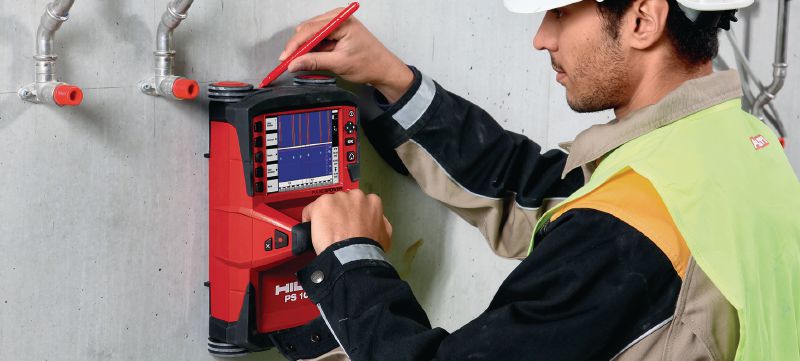Find RainierGPR Service Areas Near You for Expert Concrete Scanning
Find RainierGPR Service Areas Near You for Expert Concrete Scanning
Blog Article
Concrete Scanning: An Important Step In The Direction Of Guaranteeing Architectural Honesty and Safety And Security
In the world of building and framework upkeep, the importance of concrete scanning can not be overstated. By utilizing advanced modern technology and methods, concrete scanning serves as a critical device in ensuring that the honesty and security of structures and bridges are maintained to the greatest standards.
Relevance of Concrete Scanning
Concrete scanning plays a critical duty in ensuring the architectural stability and safety of structures and framework jobs. By using advanced innovations such as ground-penetrating radar (GPR) and electro-magnetic induction, experts can non-destructively examine concrete structures to find prospective defects, gaps, ingrained items, and reinforcement design. This procedure enables early detection of anomalies that could endanger the security of a structure, protecting against pricey problems and making sure the safety of occupants.
Concrete scanning is particularly vital during the planning and construction phases of a job. Before drilling, reducing, or coring right into concrete, scanning assists recognize the specific places of rebar, post-tension cords, and various other ingrained aspects, reducing the danger of unintended hits that might bring about architectural weaknesses. Additionally, concrete scanning aids in quality assurance by confirming the density of concrete covers and detecting any inconsistencies that may affect the overall sturdiness of the framework. Eventually, spending in concrete scanning solutions is not just an aggressive measure to minimize risks however also a basic step in the direction of keeping the long-term safety and security and stability of structures and facilities.
Innovation for Concrete Assessment

Advantages of Early Detection
Prompt detection of structural issues can substantially reduce threats and guarantee the durability of construction tasks. By recognizing possible problems early in the building and construction procedure, stakeholders can take positive procedures to deal with problems prior to they escalate into larger and a lot more expensive problems. useful source One of the crucial benefits of early detection is the avoidance of structural failings, which can posture severe safety and security threats and bring about project hold-ups and economic losses.
Furthermore, very early discovery permits timely repairs and upkeep, which can assist extend the life-span of the framework. By dealing with issues promptly, building and construction teams can prevent costly repair services and even the need for early substitute of structural parts. This positive method not only saves money and time yet likewise improves the total safety and security and longevity of the building job.
Furthermore, very early detection can boost task preparation and decision-making by offering stakeholders with beneficial insights right into the problem of the structure. Armed with this information, project supervisors can make informed choices concerning building and construction timelines, techniques, and materials, leading to a lot more effective and effective task results.
Making Sure Structural Security
Making sure the architectural security of a construction project is extremely important to its security and durability. Concrete scanning plays a vital duty in guaranteeing structural stability by detecting possible concerns such as voids, delamination, or support rust that might endanger the stability of the structure over time.
By utilizing sophisticated scanning modern technologies like ground-penetrating radar (GPR) and electromagnetic induction, construction experts can non-invasively evaluate concrete structures to identify locations of concern underneath the surface. This aggressive approach enables for the early detection of weak points or issues, enabling punctual repairs or reinforcement to prevent architectural failures.
Normal concrete scanning during different construction stages and throughout the life process of a framework can help preserve its security, alleviate threats, and make certain the safety of occupants. By prioritizing architectural security via concrete scanning, building tasks can improve their durability and toughness, ultimately adding to greater security and durability.

Stopping Essential Failures
Executing regular assessments, such as concrete scanning, can reveal covert problems like spaces, fractures, or rust that can jeopardize the stability of a structure. By utilizing sophisticated scanning technologies like Ground Penetrating Radar (GPR) or Concrete X-ray, designers can non-destructively evaluate the condition of concrete and identify weak points that call for reinforcement or fixing.

Conclusion
To conclude, concrete scanning plays an important role in making sure architectural integrity and my sources safety and security by making use of sophisticated modern technology for early detection of possible concerns. This aggressive approach helps protect against critical failings and ensures the stability of structures. It is necessary to prioritize concrete inspection as a typical technique to secure the durability and safety and security of structures and infrastructure.
Concrete scanning plays a critical function in ensuring the structural honesty and safety of structures and infrastructure jobs. Additionally, concrete scanning help in top quality control by validating the density of concrete covers and spotting any inconsistencies that might impact the overall sturdiness of the structure. Concrete scanning plays an essential role in guaranteeing architectural stability by finding possible issues such as voids, delamination, or reinforcement deterioration that might jeopardize the honesty of the framework over time.

In conclusion, concrete scanning plays an important role in guaranteeing architectural honesty and security by utilizing innovative innovation for early discovery of prospective concerns.
Report this page